About Us
We are a pioneering research group dedicated to advancing machine intelligence for sustainability. Our mission is to create ethical AI solutions that address critical environmental and societal challenges, ensuring a balance between innovation and the well-being of our planet. We collaborate across disciplines, industries, and communities to drive impactful change for a greener and more equitable future.
Our Vision
Our Mission
Enabling sustainable innovation of intelligent solutions across multiple disciplines for the benefit of all.
Encourage creative innovative research works to provide smart solutions to the industry and society.
Offering new innovations and better solutions, backed by a strong commitment and after-deployment support to ensure client total satisfaction.
Our Value
Research Areas
Smart Agro-AI & Aquatech (AI-AgroBlue)
Focus: AI, IoT, and Blockchain for sustainable agriculture, aquaculture, and food traceability.
Key Themes:
Precision farming using drones and sensors
AI for aquaculture health and yield prediction
Supply chain optimization and blockchain certification
Agrofood price prediction using AI models
Justification: Aligns with UMS’s rural development goals and Malaysia’s food security agenda.
SDG Alignment:
SDG 2 – Zero Hunger
SDG 9 – Industry, Innovation, and Infrastructure
SDG 12 – Responsible Consumption and Production
This cluster supports national goals in food security and technological advancement while empowering local farmers with AI-enhanced decision tools.
AI for Health & Assistive Technologies (AI-HealthAssist)
Focus: Deploying explainable and ethical AI in healthcare diagnostics, elderly monitoring, and rural clinics.
Key Themes:
Explainable AI (XAI) in diagnosis (dementia, stroke, diabetes)
AI-powered telemedicine and rural health accessibility
Federated learning for privacy-preserving medical AI
Assistive robotics for elder care
Justification: Bridges Sabah’s rural healthcare gaps; aligns with SDG 3 and National Precision Health strategies.
SDG Alignment:
SDG 3 – Good Health and Well-being
SDG 10 – Reduced Inequalities
SDG 4 – Quality Education (via medical training and knowledge transfer)
This cluster enhances rural healthcare delivery and helps build ethical, transparent AI in public health contexts.
Intelligent Environment & Biodiversity Analytics (AI-Nature)
Focus: Using AI to monitor and preserve Sabah’s marine, forest, and climate ecosystems.
Key Themes:
UWB and AI for marine biodiversity traceability
AI in climate modeling and natural disaster prediction
Remote sensing and drone-based wildlife monitoring
Federated sensor networks for protected zones
Justification: Builds on Sabah’s biodiversity and supports Malaysia’s SDG commitments and IR4.0 climate agenda.
SDG Alignment:
SDG 13 – Climate Action
SDG 14 – Life Below Water
SDG 15 – Life on Land
This cluster ensures that Sabah’s ecosystems are digitally safeguarded through cutting-edge, context-aware AI tools.
AI for Culture, Policy & Inclusive Digital Society (AI-Civic)
Focus: Leveraging AI for cultural heritage, governance, education, and social innovation.
Key Themes:
Indigenous language preservation through NLP
AI ethics, governance, and responsible use
Smart governance tools for rural and urban planning
AI-powered education platforms and digital inclusion
Justification: Supports local culture, smart policy, and AI for society pillars in the National AI Roadmap.
SDG Alignment:
SDG 11 – Sustainable Cities and Communities
SDG 10 – Reduced Inequalities
SDG 16 – Peace, Justice, and Strong Institutions
This cluster promotes culturally sensitive, inclusive, and ethically governed AI systems for societal transformation.
History
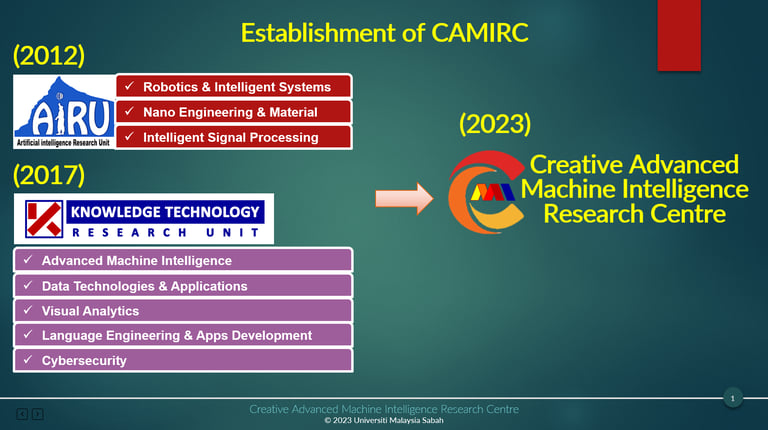

Establishment of CAMIRC
The Creative Advanced Machine Intelligence Research Group (CAMIRC) was established in 2023 as a result of merging two research units named Artificial Intelligence Research Unit (AiRU) that was established in 2012 and Knowledge Technology Research Unit (KTRU) that was established in 2017.
AiRU consists of three research groups named Robotics and Intelligent Systems, Nano Engineering and Material and Intelligent Signal Processing. While KTRU consists of five research groups named Advanced Machine Intelligence, Data Technologies & Applications, Visual Analytics, Language Engineering and Applications Development and Cybersecurity.
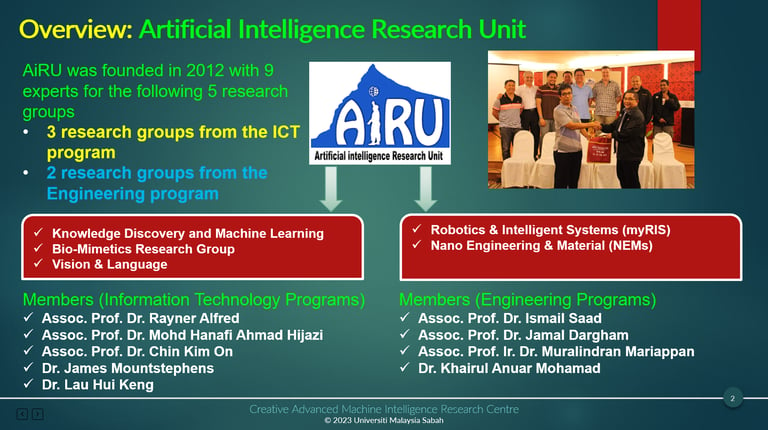

Artificial Intelligence Research Unit - 2012
AiRU was founded in 2012 by a team of nine experts with the vision of advancing research and innovation. It is structured into five specialized research groups under two key programs: the ICT program and the Engineering program. The ICT program consists of three groups—Knowledge Discovery and Machine Learning, which develops data-driven systems and predictive tools; Bio-Mimetics, which creates technologies inspired by nature; and Vision & Language, which integrates visual and textual data for smarter AI solutions. The Engineering program comprises two groups—Robotics & Intelligent Systems (myRIS), focusing on autonomous robots and intelligent systems, and Nano Engineering & Materials (NEMs), which drives innovation in nanotechnology and materials science. Together, these groups collaborate to tackle complex challenges and contribute to groundbreaking advancements across diverse fields.

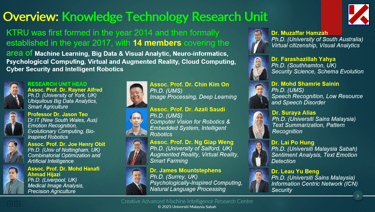
Knowledge Technology Research Unit - 2017
The Knowledge Technology Research Unit (KTRU) was first formed in 2014, with the aim of fostering innovation and advancing technological research. It became formally established in 2017, bringing together a team of 14 skilled professionals who specialize in various groundbreaking fields. KTRU’s work spans across diverse domains, including Machine Learning, where intelligent algorithms are developed to analyze data and predict outcomes, and Big Data & Visual Analytics, focusing on processing and visualizing large datasets for actionable insights. The unit also explores Neuro-informatics, merging neuroscience and informatics to model brain function, as well as Psychological Computing, which emphasizes analyzing emotional and psychological factors to improve human-computer interaction. Additionally, KTRU delves into the transformative realms of Virtual and Augmented Reality to create immersive experiences, Cloud Computing for scalable data solutions, Cyber Security to protect digital systems, and Intelligent Robotics to design advanced robots capable of automation and adaptation. This multidisciplinary approach positions KTRU as a leader in driving innovation and shaping the future of technology.
Research Groups in KTRU
The Knowledge Technology Research Unit (KTRU) strives to address emerging technological needs by bringing together faculty and students interested in conducting advanced research. Established formally in 2017, KTRU focuses on five key research groups: Advanced Machine Intelligence (AMI), which promotes sustainable innovation in intelligent solutions through Neuro-informatics, Psychological Computing, and Knowledge Discovery and Machine Learning; Data Technologies & Applications (DATA), conducting impactful research in Big Data Analytics, Data Science, and Software Technologies; Language Engineering and Application Development (LEAD), which produces robust and scalable digital solutions through Machine Translation, Corpus Analysis, Sentiment Analysis, Document Summarization, and Human-Language-centered applications; Cybersecurity (CS), advancing superior research in Internet Security, Data Protection, and Socio-technical Security; and Visual Analytics (VA), enhancing skills in Virtual Citizenship, Visual Analytics, and Augmented and Virtual Reality across disciplines. Together, these groups contribute to KTRU's vision of driving innovation and fostering impactful research.
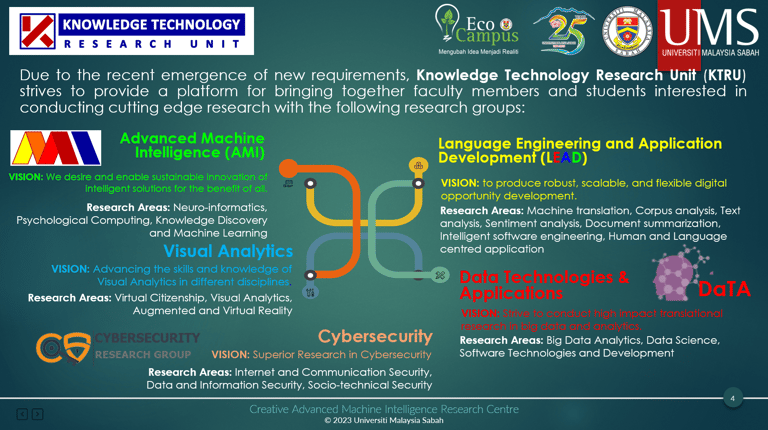

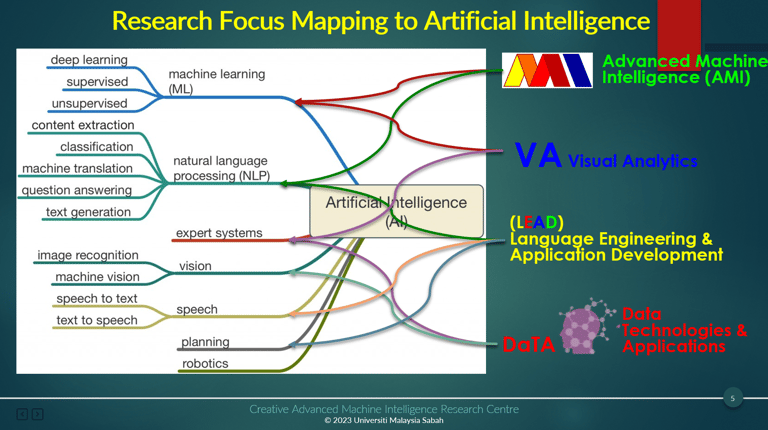

Research Areas Mapping to AI
The research groups of the Knowledge Technology Research Unit (KTRU) focus on diverse and innovative fields. The Advanced Machine Intelligence (AMI) group works on intelligent solutions through Neuro-informatics, Psychological Computing, and Knowledge Discovery & Machine Learning. Data Technologies & Applications (DATA) emphasizes impactful research in Big Data Analytics, Data Science, and Software Development. Language Engineering and Application Development (LEAD) specializes in creating scalable digital tools, focusing on Machine Translation, Corpus Analysis, Sentiment Analysis, and Human-Language applications. Cybersecurity (CS) prioritizes advanced research in Internet Security, Data Protection, and Socio-technical Security. Lastly, Visual Analytics (VA) enhances expertise in Virtual Citizenship, Visual Analytics, and Augmented/Virtual Reality, driving forward advancements across disciplines.
Research Areas Mapping to 4IR
The Fourth Industrial Revolution (4IR) emphasizes the integration of advanced technologies to transform industries and societies. Research focus areas aligned with 4IR include Artificial Intelligence and Machine Learning for intelligent automation, Big Data Analytics for decision-making, Cybersecurity to safeguard digital ecosystems, Internet of Things (IoT) for interconnected systems, and Augmented and Virtual Reality for immersive experiences. Additionally, 4IR research explores Robotics for smart manufacturing, Blockchain for secure transactions, and Sustainable Technologies to address environmental challenges. These areas collectively aim to drive innovation, enhance productivity, and create a more connected and efficient world.
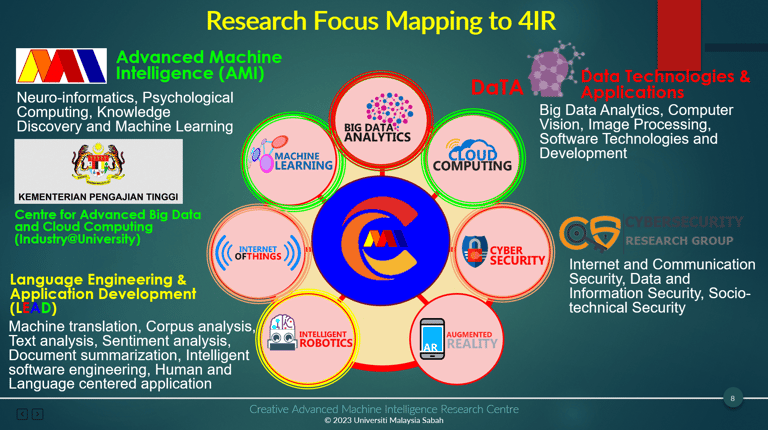



Research Direction
The research focus spans several innovative domains: Smart Hospital & Healthcare emphasizes advanced systems for disease diagnosis, patient monitoring, outbreak prediction, and smart health records; Smart Tourism leverages forecasting, augmented and virtual reality, and geo-location analytics to enhance travel experiences; Smart Agriculture & Food Security targets sustainable practices through crop and soil monitoring, precision farming, halal food systems, and supply-demand forecasting; Indigenous Culture & Language Engineering supports cultural and linguistic preservation with tools like text translation, academic chatbots, and augmented reality; Biodiversity & Environmental Sustainability concentrates on climate prediction, sustainable land use, habitat protection, and biodiversity monitoring; and Smart Security & Transportation develops technologies for biometric authentication, video surveillance, object tracking, and traffic management to ensure safety and efficiency
Get in Touch with Us
Reach out for inquiries about our AI research and collaborations.


